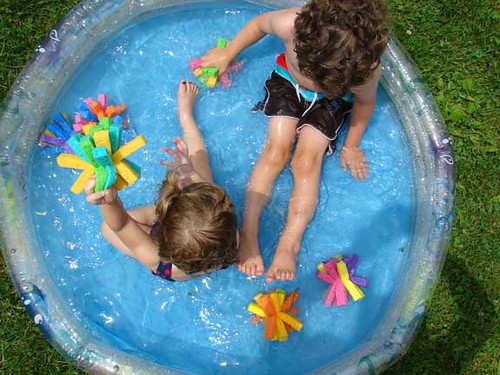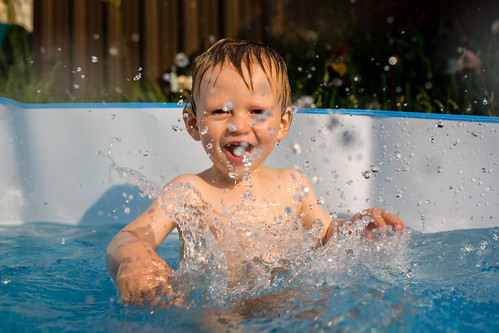Swim lessons can be costly, but are vital for children's safety. Taking lessons from a certified instructor is your best bet if you really want your child to learn the skills needed for swimming. However, there are lots of activities you can do to help prepare them for lessons. I touched upon being comfortable in the water last year. This year I am sharing my outline for backyard swim lessons.
It is important to note that this is NOT a swim instructor course and it in no way certifies the reader as a swim instructor. If you are interested in becoming a swim instructor, please get in touch with your local Red Cross, YMCA, or community college.
These lessons are set up sequentially over a 6 week period for children ages 2-4. Each week the lesson should be repeated 2-3 times. A lesson is 20-30 minutes long, depending on how many children you are working with and how interested they are with the games. I do these lessons in our kiddie pool, which is around 12" deep.
FREE DOWNLOAD - These cards can be cut out & laminated to keep near your swimming area. Follow the link to see which activities to do each week.

Activity Descriptions
Speckled Frog Song
Raffi's Speckled Frog Song is the commonly known version of this counting song. This brings all the children to the poolside. It also lets you work one on one with each child so that you can judge how comfortable they are with the water on that particular day. In a small pool: it would be an observation of how quickly they get into the water, if they get their face wet, and if they jump and splash. In a larger pool: it would be an observation of how relaxed or rigid their body is, if they are using their arms for splashing or clinging, and if they are letting their face get wet.
To get started, have all the children sit on the edge of the pool. Count the number of "frogs" you have at the pool. As you count down in the song bring them one at a time to swim with you, then return them to the side.
Five little speckled frogs
Sat on a speckled log
Eating some most delicious grubs - yum, yum
One jumped into the pool
Where it was nice and cool
Now there are four green speckled frogs - glub, glub.
Sat on a speckled log
Eating some most delicious grubs - yum, yum
One jumped into the pool
Where it was nice and cool
Now there are four green speckled frogs - glub, glub.
(and so on, until there are "no more" frogs)
Float on Back
This is one of the most important skills to be taught. If a child were to fall into water, floating on their back could save their life.
People work similarly to see-saws in the water. If the head is up, the hips are down. If you level it out with your head and hips at water level, then you float. This is difficult for young children, because it is scary. Here are some tips you can try, but don't try them all at once as that would be overwhelming. During each lesson, try one and if it works then keep going with that method.
- If you have enough room, show the children what back float looks like.
- Make sure they are not looking into the sun, use your body as shield if needed.
- Make sure the water is calm, little to no waves.
- Do a magic spell to turn the children into starfish.
- Have the child try to make their belly touch a toy floating on top of the water, like a rubber duck.
- Have the child try to make their belly button touch the top.
- Stand/sit behind the child and make funny faces to encourage them to put their head back.
- If you are in the water with them, have them lay their head on your shoulder so it is supported as it is lowered into the water.
- Tell them to get their ears wet.
- Use a very small amount of water, 1-2" deep, and have them lay in that before going to a bigger pool.
- Ask their parents to have them practice in the bathtub.
Red Light, Green Light Kicks
Effective swimming kicks are done with straight legs and pointed toes, called a flutter kick. This is a different use of muscles than those used for walking. It takes time to build those muscles, so practicing before swimming is great exercise.
This game is pretty simple. Green light means go, kicking with straight legs and pointed toes. Red light means stop, legs are still with straight legs and pointed toes. If the children do not want their faces wet, then you can have them lay on their stomachs in the water, holding onto the side of the pool.
Free Style Arms
This is another movement that is not natural. People tend to keep their arms in the water, doing a "doggy paddle" motion. This actually works against you, as it takes more energy to move your arms forward and backward in the water.

Your preschooler probably won't be swimming like Michael Phelps after these lessons, but you can encourage them to pull their arm up out of the water before reaching forward. Tell them to make their hands into spoon shapes, fingers together and cupped. Pretend the pool is filled with their favorite treat, but they have to scoop it with their spoon hands. You can encourage them to pull their elbows up by telling them that their treat is getting on their elbows, "Oh no! Sticky elbows!"
Listen to the Fishes, Talk to the Fishes
Just like with the back float, your body works like a see saw in the water when on your stomach. Good swimmers are able to put their face in the water, which relaxes their shoulders muscles and lets their body balance on top of the water.
To do this activity, show the children how to "talk to the fish" by blowing bubbles and "listen to the fish" by turning their head to put their ear in the water. You can modify this activity by putting sinking pool toys at the bottom for the children to reach for while blowing bubbles.
Ball Kicking Game
This is another activity to strengthen leg muscles. In a small pool, have the children sit around the edge and put a ball in the center of the pool. They will kick their feet in order to move the ball, the goal being to keep the ball in the pool but pass from friend to friend.
In a large pool, you can have children use bubbles (waist band floats) and pool noodles for supports. Only do this in a large pool if you have confident swimmers and you are comfortable watching that many children at a time on pool noodles.
Bucket Head
This is another activity meant to increase comfort and confidence in the water. In this activity, the first person asks, "Do you want to be a bucket head?" If the second person agrees, then the first will dump a bucket of water over the other's head. This is best done by the adult first, so that modeling of yes and no responses can be seen. This can be a very exciting and silly activity. Be prepared to help children respect the boundaries of others.
Simon Says
Simon Says is pretty well known. Usually with this age I do not make children "go out" for not following the direction. The purpose for Simon Says during a swim lesson is to recall the name of skills practiced then demonstrate knowledge of that skill. It is a fairly decent assessment tool. Skills that were done in this particular set of lessons are: back float, flutter kick, free style arms, blowing bubbles (talk to fishes, listen to fishes), getting you hair wet, getting your face wet. You can vary the directions by adding stipulations like go fast, go slow, or restrict the number of times they do a motion.
5 Little Fishies
This is a fun counting song to end with. Usually the children want to do it several times so that they can all have a turn to be the shark. You use the number of children present, minus the shark if a child is going to be the shark.
5 little fishes swimming in the sea.
Teasing the big shark, "You can't catch me!"
Along came the big shark as quiet as can be,
And snapped that fish right out the sea!
(the shark then claps their hands at one the fish,
who then gets out of the pool)
(continue until there are no more fish in the sea)
Keep in mind, this is in no way an extensive list of beginning swim skills nor the only way they can be taught. It is a good place to start if you want to help your children become comfortable with swimming in a fun and relaxed setting. Enjoy!!



Comments
Post a Comment